When I knew that a new restaurant had Pozole Verde Guerrero on their menu, I knew I wanted Jack Jacobs as my date. Jack had helped me lose my pozole virginity at La Alborada over on Sollano about ten years ago. And in case you don’t know, a guy introducing you to pozole ranks somewhere up there with a guy introducing you to his hot little sister.
Jack was at the same dinner as Don Day’s Wife and I and, when I asked if he might be needing pozole tomorrow. He said “I will” almost as fast as he did to his new wife, Rosie.
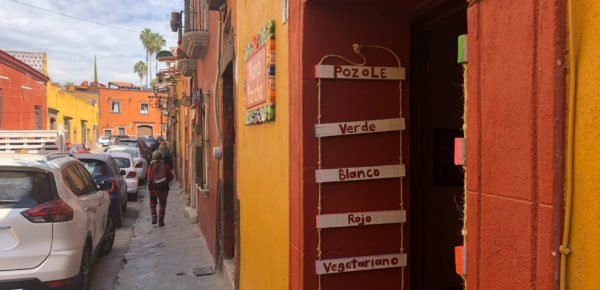
The restaurant is called Nana Pancha. It’s what an old Zapateria on Calle Codo became about six months ago.
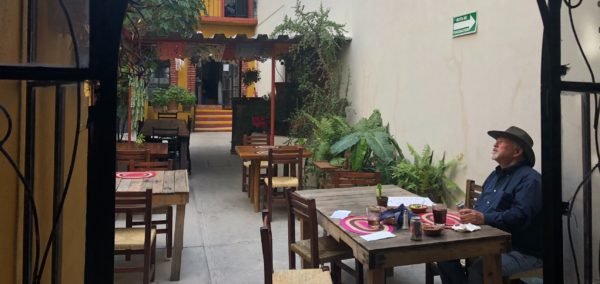
The menu has a few intriguing Mexican dishes (Nana Pancha is one of those rare new restaurants that is smart enough to put their menu on their Facebook page; you’ll find it at https://m.facebook.com/NaNaPanchaRestauran/menu/?ref=page_internal&mt_nav=0). What really caught my eye was the pozole. No, make that pozoles, plural. Four of them. Which is two more than any other restaurant I know of in San Miguel de Allende. Or anywhere else in the rest of the world. Not only that, I saw on the menu that the verde version included that somewhat strange but sometimes special ingredient from the west coast style of green pozole. Nana Pancha’s pozole verde apparently had sardines.

Before I tell you about that pozole though, perhaps I should share some general info just in case you may still be a pozole virgin like I unfortunately was for far too many decades of my life.
History and hangovers. That’s what I think of most when I hear the word pozole (and it’s a word I love to say…even though I can never get the pronunciation of the “z” quite right). Pozole is the most famous pre-Columbian dish in Mexico. And, after its sister stew menudo, pozole is the second most famous morning-after-the-night-before dish in Mexico.
Pozole is usually a pork and corn broth but it has many variations and the original version had an ingredient that is absolutely impossible to find in any San Miguel de Allende butcher shop. Pozole (sometimes posole, pozxole or pozolli) is mentioned in “General History of the Things of New Spain” written around 1500 by Fray Bernandino de Sahagun. If you’re at all interested in Mexican history you’ll probably find it as fascinating as I did. Copyrights have long expired so you can easily search out a copy online to download.

In the book, Fray Bernandino describes a feast where, in tribute to the god Xipe, Emperor Moctezuma was served a huge pot of pozole topped with the thigh of a prisoner who had been slaughtered by tearing his heart out in a ritual sacrifice. After the Spanish conquest, when cannibalism was heartily discouraged, pozole con carne humana soon became pozole con carne cerdo as, according to a Spanish priest again, pork tasted “quite similar” to human flesh. The corn in pozole is also historically significant because ancient Mexicans believed that the gods created humans from cornmeal dough.
Pozole is believed to soak up some of the evil spirits that the old devil may have stirred in a glass and, like menudo, the other traditional hangover dish, it is often consumed the morning after due to the same medicinal claims. I knew I was close to opening double digits of red wine bottles on Christmas Eve and, as Jack Jacobs said to me the next morning at Nana Pancha, “I might have had a little too much whiskey last night”. Pozole was obviously very apropos for what ails us.

Pozole is traditionally made from a large kerneled white corn called cacahuazintle (no, I’m not sure how to pronounce it either) that is boiled in a solution containing slaked lime or “cal” (calcium hydroxide) for a couple of hours until the outside husks are freed and a frothy stew is left. The word pozole meaning frothy or foamy comes from the Nahuatl word potzolli which had a similar meaning.
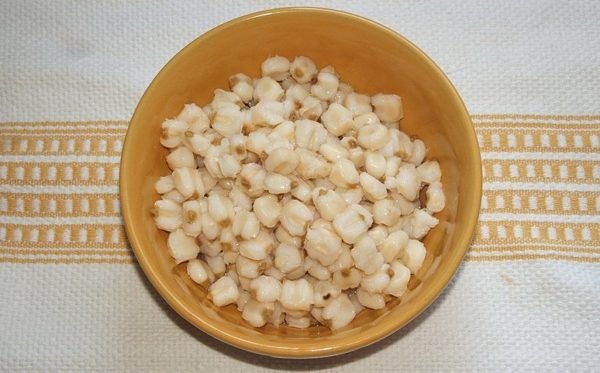
If you want to prepare your own nixtamal (the name of the finished corn), you’ll find step-by-step instructions online. Alternatively, you can simply go to Bonanza or any other San Miguel supermarket or small grocery store and buy your hominy (the common English term for the corn) in plastic bags or cans. I think the nixtamal in bags or cans is just as good as homemade. So does Nana Pancha’s chef Annelle Castilla.
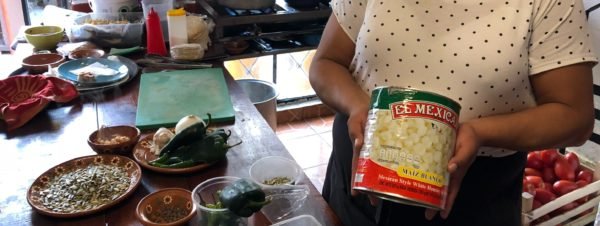
Every pozole has a corn base, but from that point on, the ingredients can vary considerably from Mexican state to state and town to town. The most basic recipes contain only boiled pork shoulder and salt plus perhaps a little garlic or cumin. Commonly called pozole blanco, that’s how you’ll usually find it in Guadalajara.
In some areas, chicken is used instead of pork and in coastal areas, those sardines that Nana Pancha apparently adds to their Pozole Verde Guerrero are included.
The addition of dried ancho or guajillo chiles is more traditional in the states of Jalisco and Sinaloa where their version is called pozole rojo and that’s the one that took away my virginity, still remains my favorite, and what Jack Jacobs ordered at Nana Pancha.
On the other side of the table, I had to have the restaurant’s pozole verde. I had to have the one with the sardines. For no other reason than to cross it off my ever-growing-smaller food bucket list.
I love when a green and a red pozole both arrive at the table. It’s a reminder of how wonderful it is to live in a town of 100,000+ people that still doesn’t have a single traffic light.

Jack’s red pozole was that deep rich red you find on candy apples and ’66 Ford Fairlanes. I watched, apprehensively, as he added the traditional Mexican flag toppings…radishes (Nana Pancha grows their own), onions and lettuce, squeezed a wedge of lime, and skimmed a spoonful of the juice from the top. I would rank Jack Jacobs as a pozole aficionado and I know he has a deep affection for La Alborada’s pozole rojo (perhaps once his first time was there as well). I know any other pozole has only a snowball’s chance of being celebrated.

Jack shook his head, screwed up his mouth a little and said, “It just doesn’t have enough heat…but then I do like a lot of heat.”
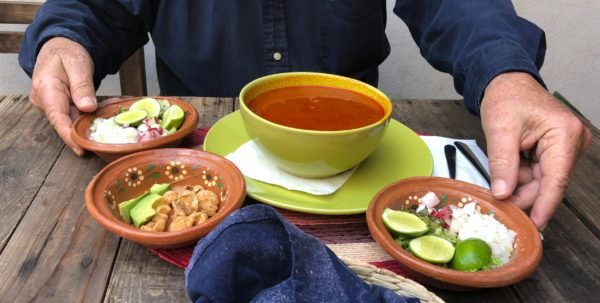
I asked permission to dip my spoon and try it. My temperature tolerance is a lot lower. My nod was a little more up and down than sideways but I agreed it wasn’t the spiciest pozole rojo I’d ever had. It was right about then though that we realized what was missing from the table. That bowl of dried chiles that’s usually de rigeur when any pozole is presented.

Chef Annelle brought us a bowl of what she called pimienta; Jack sprinkled a few, reminded himself what parts of his body he shouldn’t touch that afternoon, and, after a stir, Jack’s nod changed directions.
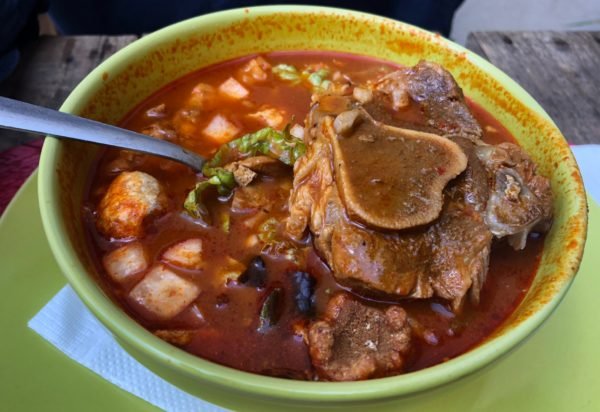
It was also after a stir that Jack realized there was something very special about Nana Pancha’s red pozole. Most pork-based pozoles use the second best tasting part of a pig, the shoulder. Annelle Castilla’s recipe uses the very best tasting part of a pig, the shank. I looked at it and Jack saw me looking. Over came a juicy chunk. It was melt-in-the-mouth and extraordinary in its depth of taste.

My Guerrero style pozole was pea soup green and the taste of pumpkin seeds along with jalapeño and poblano chiles added a freshness to the chicken broth. Cumin and Mexican oregano nicely complimented the flavor and topping it with avocado and chicharrons (pork rinds) enhanced it. And the taste of the sardines? Nothing. I couldn’t taste them at all. I thought maybe they were like anchovies and, if used sparingly, simply add an interesting saltiness to a broth.
I summoned Annelle.
“I thought your recipe was for Guerrero style; I thought it included sardines”, I inquired. “I don’t think I could taste them.”

“My recipe does”, replied Annelle, “but I didn’t put any in.”
“Why?”, I asked.
“Because absolutely nobody ever likes sardines in their pozole. Never. But next time I can put some in if you want.”
And would I be back for that occasion? I already have been. As has Jack Jacobs. Of course we have. I even brought Chef Annelle a present.
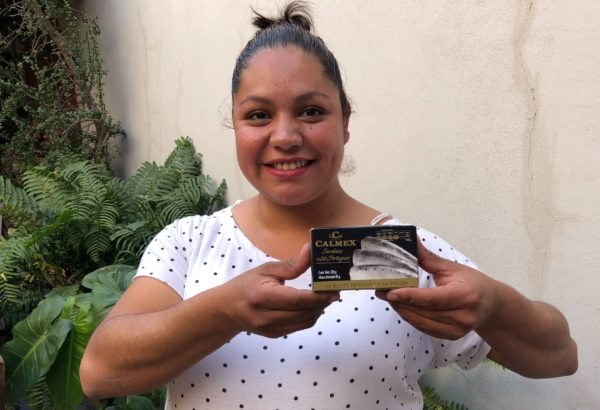
And was she ever right about those sardines. There’s still nobody who “ever likes sardines in their pozole”.
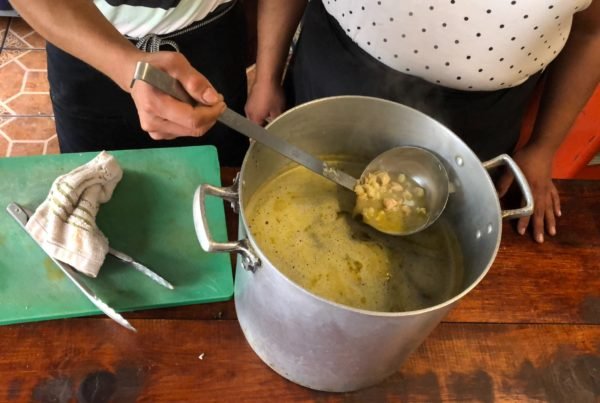
Nana Pancha has very good red pozole and, perhaps, the best green pozole you’ll taste in San Miguel de Allende. And where there’s good pozole, I know at least two good guys who are going to be there.
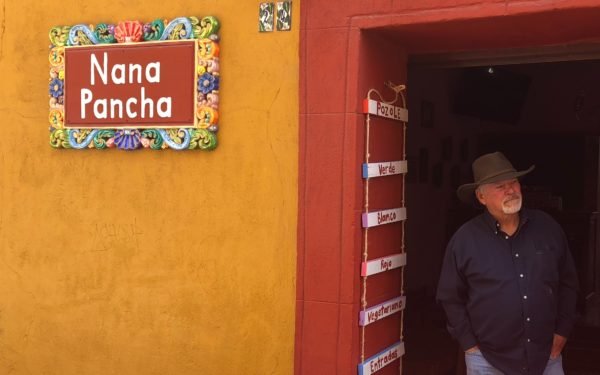
Restaurante Nana Pancha is located at Codo #24 in San Miguel de Allende, Mexico. They are open from 9:00 am to 9:00 pm every day but Tuesday.
And if you are wondering where the name of the restaurant comes from, like Jack Jacobs and I certainly were, Annelle Castilla told us the origin is a cheeky little song by Pedro Infante which you can hear him sing (and watch him dance the cha-cha-cha to) here:
https://youtu.be/Na8k8cfKx74

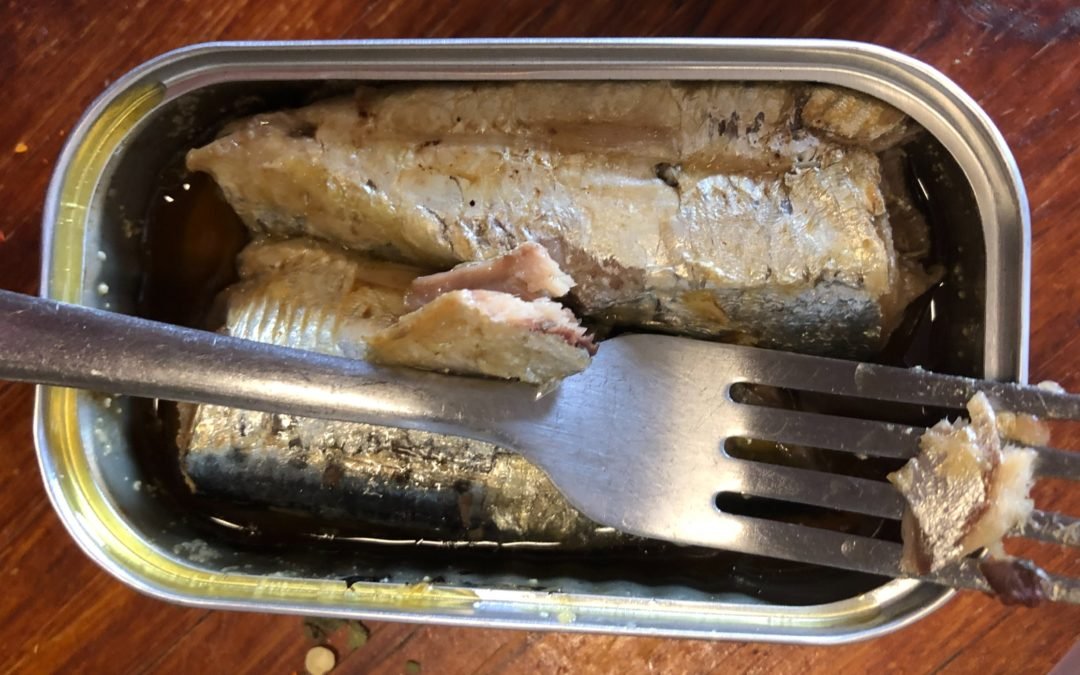
Pazole looks good — but no to the sardines!
Very interesting. I understand that in rural parts of Mexico it is typical to use the entire pig-head as the meat portion of pozole; not so nice aesthetically on the cooking side, but perhaps very tasting on the eating side.
We enjoyed the pazole at Nana Pancha yesterday. Thanks for the suggestion! Muy delicioso! I hope the restaurant does well.
The best…..especially during the rainy season! And there are some cute Botero like paintings on the walls by Annells father. April and Brian
This place has been closed on open days. And the family owns cafe contento on macias and it is 1. Being renovated 2 renovated for a new cafe 3. Closed. ???????? Darn
Not sure what’d happening to Cafe Contento either but I wish I did.